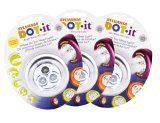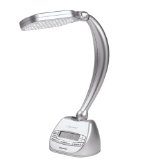
LED sales mushroom
The electric light bulb has been in existence for 131 years, but its dominance may be drawing to an end.
We have often written in the past about the lightemitting diode (LED), which can end the darkness for poor villages in the third world, slash energy consumption in the wealthiest parts of the West and give you long-life illumination for very little energy consumption if you are off-grid.
In truth, the light bulb was a great idea but never a very good technology(except for manufacturers of light bulbs who made billions). Worldwide about 20% of all electricity generated is used for lighting. Now several studies reckon that LEDs could eventually cut that amount in half.
 Dot-It Self-Adhesive Bright White LED Light, Silver, 3-PACK – buy it from Amazon
Dot-It Self-Adhesive Bright White LED Light, Silver, 3-PACK – buy it from Amazon
The Economist has devoted a section of the current magazine to the subject. Since LEDs were first invented over four decades ago, they have mostly been used in niche applications, first as simple indicator lights on calculators or watches and then, as their brightness improved, in displays, signs and traffic signals. More recently, some companies have begun to sell LED fixtures for residential use. We’re on the brink of a new lighting revolution, says Jerry Simmons, head of the solid-state lighting programme at America’s Sandia National Laboratory.
LEDs have become popular because they have numerous advantages over conventional light bulbs. For one thing, they last much longer: they can endure up to a decade of non-stop use compared with a few months or less for incandescent bulbs. They also take up much less space (a typical LED is about the size of the rubber on the end of a pencil), are shock resistant and, perhaps most important of all, are extremely energy-efficient.
An incandescent bulb, made of a wire filament encased in glass, emits only 5% of the energy it consumes as light; the rest is wasted as heat. Fluorescent lights, which consist of tubes filled with mercury vapour, are roughly four times more efficient. LEDs, however, contain no mercury and already rival fluorescents in efficiency. Upfront costs make them too expensive for most general lighting applications, but experts expect that to change over the next five years as prices come down and efficiencies go up.
 Light Therapy Lamp – buy it from Amazon
Light Therapy Lamp – buy it from Amazon
Besides being environmentally friendly, LEDs allow unprecedented control over lighting. Unlike incandescent or fluorescent lamps, which spew light in all directions, LEDs generate directional light, making them ideal for selectively illuminating areas. Moreover, the ability to mix and match the output of red, green and blue LEDs makes it possible to tune the emitted light to produce any desired colour.
In 2005, the projected growth rate for the LED market is 11%, says Jagdish Robello,
– In 2010, the iSuppli forecast is for a total LED market of $7.34 billion, up from $2.42 billion in 2001.
“Based on what I’ve seen in terms of the technology, and based on the fact that Lumileds is now a fully owned subsidiary of Philips, I see the first LED light bulbs appearing in 2010. That’s not the one where we can go to Home Depot and buy it. It would be mostly for the enterprise segment,” he says.
“It will still be two to three times the cost of an incandescent light bulb. But from the enterprise point of view, the cost of changing light bulbs every year is quite high. The long life that will be afforded by the LED light bulb will outweigh the disadvantages of the high upfront costs. The barrier to entry in that market will be a little lower,” he says.
Replacing many current light sources with LEDs is not a question of “if” but of “when,” points out Robello. “All of the leading lighting manufacturers have some interest, through various collaborations, in looking at LED light sources.”
Robello says his estimates tend to be conservative. “To a large extent, the upside potential of LEDs [when they hit the illumination market] will only be limited by the imagination,” he says.
Part of that upside potential is from new applications as people dream of them.
“In existing applications, right now there are a few, small esoteric applications that are being looked at with LEDs that can’t be looked at with traditional lighting sources,” he explains.
One example is a thin LED sheet that could be used as a curtain in northern regions of the U.S. and Scandinavia where long winters mean little daylight.
“The LED light could come on slowly in the evening, and people would get the effect of extended daylight,” he says.
iSuppli’s recently released report is called “Solid State Lighting: Increasing Brightness Key to Expanding Illumination Market.” More information about this report, is available online at the iSuppli site.
So how many scientists does it take to change a lightbulb? Just two both Japanese — who worked hard on the research in the 1980s, and ended up having to take their employers to court to get paid.